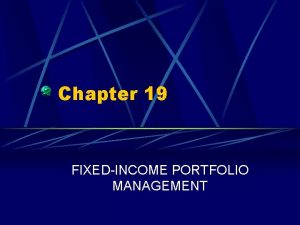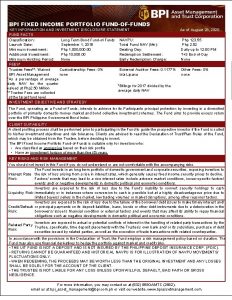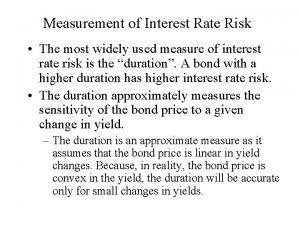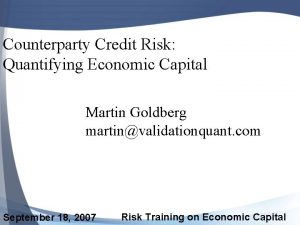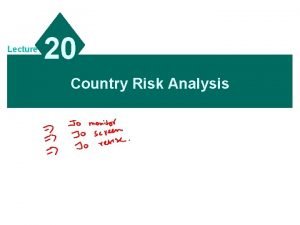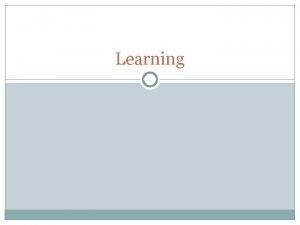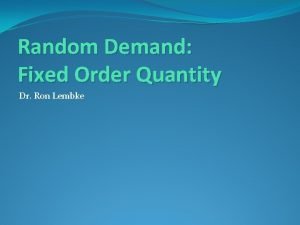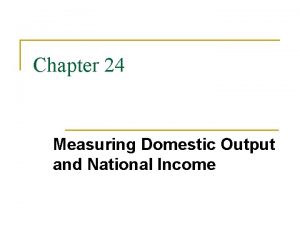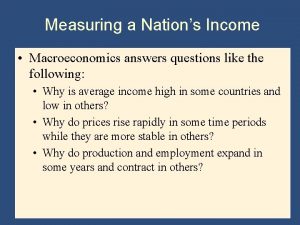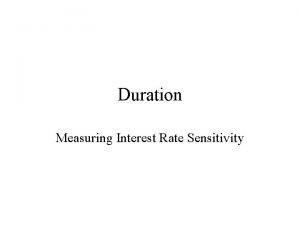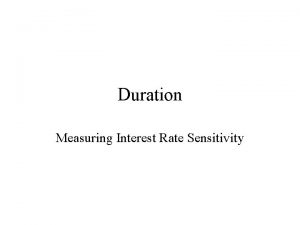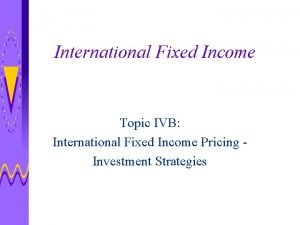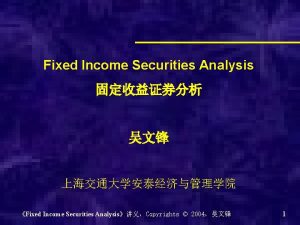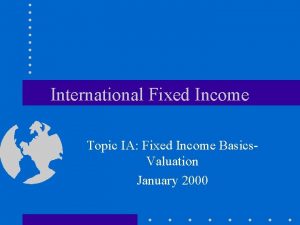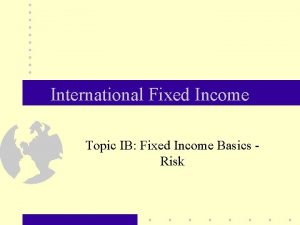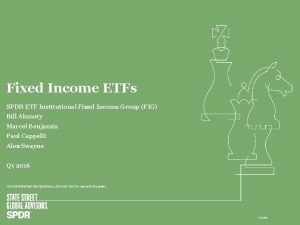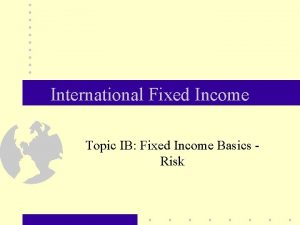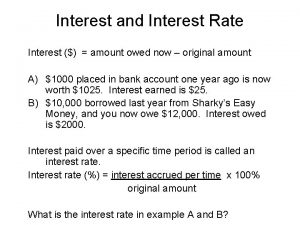Fixed Income portfolio management quantifying measuring interest rate
















- Slides: 16

Fixed Income portfolio management: - quantifying & measuring interest rate risk Interest rate risk measures: Duration Convexity PVBP Interest Rate Risk Management Finance 30233, Fall 2010 S. Mann

Zero-coupon bond prices for various yields & maturities



Duration Bond price (Bc) as a function of yield (y): Small change in y, Dy, changes bond price by how much? Classical duration weights each cash flow by the time until receipt, then divides by the bond price:

Modified Duration Define DM = Dc /(1+y) (annual coupon) = Dc /(1+y/2) (semi-annual coupon) ( modified duration) approximate % change in Price: DP/P = - DM x Dy example: DM = 4. 5 Dy= + 30 bp expected % price change= -4. 5 (. 0030) = -1. 35% linear approximation. Convexity matters.

Modified duration Percentage change in bond price: Modified Duration (DM): DM = Dc/(1+y) DM = Dc/(1+y/2) Change in bond price: Duration is linear approximation (annual coupon) (semiannual coupon)

Duration for an annual coupon bond

Duration for a semi-annual coupon bond

Duration for a semi-annual coupon bond

Price Value of Basis Point (PVBP) PVBP = DM x Value x. 0001 Example: portfolio value = $100, 000; DM = 4. 62 PVBP = (4. 62) x 100, 000 x. 0001 = $46. 20 Exercise: estimate value of portfolio above if yield curve rises by 25 bp (in parallel shift). Food for thought: what about non-parallel shifts?


Convexity: adjusting for non-linearity Predicted % price change using duration: DP/P = -Dm Dy Duration is FIRST derivative of bond price. (slope of curve) convexity is SECOND derivative of bond price (curvature: change in slope) Using duration AND convexity, we can estimate bond percentage price change as: DP/P = - Dm. Dy + (1/2) Convexity (Dy)2 (a 2 nd order Taylor series expansion) (the convexity adjustment is always POSITIVE) (We will not hand-calculate convexity)

Example using Convexity example: 30 year, 8% coupon bond with y-t-m of 8%. Modified duration = 11. 26, Convexity = 212. 4 What is predicted % price change for increase of yield to 10%? Duration prediction: DP/P = - Dm. Dy = -11. 26 x 2. 0% = -22. 52% Duration & convexity prediction: DP/P = - Dm. Dy + (1/2) Convexity (Dy)2 = -11. 26 x 2. 0% + (1/2) 212. 4 (. 02)2 = -22. 52% + 4. 25% = -18. 27% Actual % price change: price at 8% yield = 100; price at 10% yield = 81. 15. % change = -18. 85%

Asset-Liability Interest Rate Rrisk Management Example: The Billy. Bob Bank Simplified balance sheet risk analysis: Assets Amount $100 mm Duration 6. 0 Liabilities 90 mm 2. 0 Equity 10 mm ? ? ? PVBP 100, 000 x 6. 0 x 0. 0001 = $60, 000 90, 000 x 2. 0 x 0. 0001 = PVBP(E) = PVBP(A) – PVBP(L) = 60, 000 – 18, 000 = $42, 000 Q: What is effective duration of equity? PVBP(E) = DE x VE x 0. 0001 $42, 000 = DE x ($10, 000) x 0. 0001 DE = $42, 000/$1000 = 42. 0 18, 000

The Billy. Bob Bank, continued Simplified balance sheet risk analysis: Amount Assets $100 mm Liabilities 90 mm Equity 10 mm Duration 6. 0 2. 0 42. 0 PVBP 100, 000 x 6. 0 x 0. 0001 = $60, 000 90, 000 x 2. 0 x 0. 0001 = 18, 000 PVBP(E) = PVBP(A) – PVBP(L) = 60, 000 – 18, 000 = $42, 000 Assume that the bank has minimum capital requirements of 8% of assets (bank equity must be at least 8% of assets) Q: What is the largest increase in rates that the bank can survive with the current asset/liability mix? A: Set 8% = E / A = ($10 mm - $42, 000 Dy) / (100 mm – 60, 000 Dy) and solve for Dy: 0. 08 (100 mm – 60, 000 Dy ) $8 mm – 4800 Dy (42, 000 – 4800) Dy Dy = 10 mm - 42, 000 Dy = $2, 000, 000/$37, 200 = 53. 76 basis points
 Nominal v. real interest rates
Nominal v. real interest rates Active fixed income portfolio management strategies
Active fixed income portfolio management strategies Bpi fixed income portfolio fund-of-funds
Bpi fixed income portfolio fund-of-funds How is interest rate risk measured
How is interest rate risk measured Cap rate interest rate relationship
Cap rate interest rate relationship Twitter
Twitter Quantify the uncountable noun
Quantify the uncountable noun Martin goldberg economic invincibility
Martin goldberg economic invincibility George theodorakopoulos
George theodorakopoulos When quantifying country risk:
When quantifying country risk: Continuous reinforcement schedule
Continuous reinforcement schedule Fixed ratio schedule
Fixed ratio schedule Fixed ratio fixed interval
Fixed ratio fixed interval Fixed order quantity
Fixed order quantity Fixed logic
Fixed logic Measuring domestic output and national income
Measuring domestic output and national income Measuring a nation's income
Measuring a nation's income

